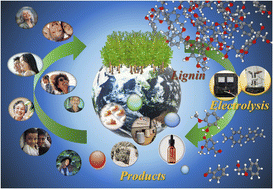Degradation of three β-O-4 lignin model compounds via organic electrolysis and elucidation of the degradation mechanisms†
Abstract
Woody biomass comprising cellulose, hemicellulose, and lignin has been the focus of considerable attention as an alternative energy source to fossil fuel for various applications. However, lignin has a complex structure, which is difficult to degrade. Typically, lignin degradation is studied using β-O-4 lignin model compounds as lignin contains a large number of β-O-4 bonds. In this study, we investigated the degradation of the following lignin model compounds via organic electrolysis: 2-(2-methoxyphenoxy)-1-(4-methoxyphenyl)ethanol 1a, 1-(3,4-dimethoxyphenyl)-2-(2-methoxyphenoxy)-1,3-propanediol 2a, and 1-(4-hydroxy-3-methoxyphenyl)-2-(2-methoxyphenoxy)-1,3-propanediol 3a. The electrolysis was conducted for 2.5 h at a constant current of 0.2 A using a carbon electrode. Various degradation products such as 1-phenylethane-1,2-diol, vanillin, and guaiacol were identified upon separation via silica-gel column chromatography. The degradation reaction mechanisms were elucidated using electrochemical results as well as density functional theory calculations. The results suggest that the organic electrolytic reaction can be used for the degradation reaction of a lignin model with β-O-4 bonds.



 Please wait while we load your content...
Please wait while we load your content...